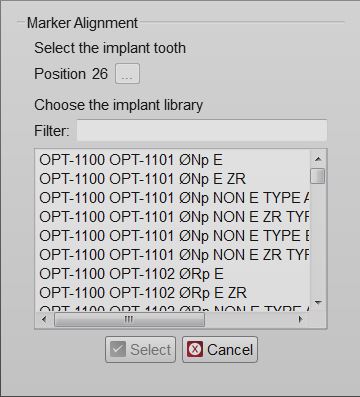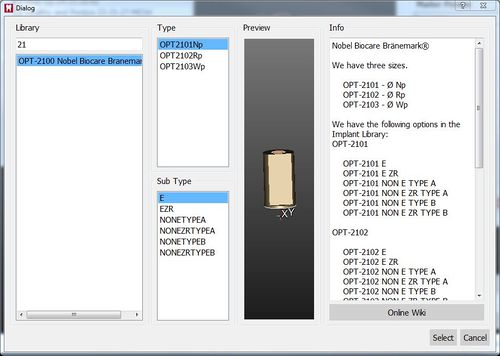Difference between revisions of "Man ImplantAlign/fr"
(Created page with "{{Screenshot|Dental_3_5_implantSelectionPanel.JPG}}") |
(Created page with "'''Bibliothèque'''") |
||
| Line 29: | Line 29: | ||
{{Screenshot|Dental_3_5_implantSelectionPanel.JPG}} | {{Screenshot|Dental_3_5_implantSelectionPanel.JPG}} | ||
| − | ''' | + | '''Bibliothèque''' |
For choosing the general connection and implant family, contains: | For choosing the general connection and implant family, contains: | ||
Revision as of 10:47, 3 June 2016
Acquisition des Marqueurs
Dans les projets sur implants n’est pas possible d’acquérir directement l’information de la connexion implantaire parce qu'elle est trop petite et en métal et elle n’est pas donc visible comme un moignon ou comme un modèle en plâtre.
En outre, il faut que l’alignement soit parfait du point de vue mécanique.
Pour avoir les informations nécessaires il faut numériser un Marqueur Implantaire ou un Scan Body. Ce sont des objets spécifiques, pensés pour être numérisés, qui se connectent parfaitement à l’implant.
Toutefois, la seule numérisation du Marqueur n’est pas suffisante : les données de la numérisation sont utilisées pour calculer la position exacte de l’interface implantaire. À fin de la calculer il faut avoir une Bibliothèque Implantaire
L’alignement à la bibliothèque implantaire peut être démarré dans le logiciel CAO mais le logiciel OpticalRevEng Dental offre des résultats meilleurs.
Choisir l’Implant
Apres avoir généré une maille, en sélectionnant un élément implant dans l’arbre du projet il y aura une icône pour Aligner les Marqueurs dans la Barre d’Outils Principale. Cliquer sur l’icône pour ouvrir la fenêtre de dialogue de Sélection de l’Implant.
La fenêtre a:
- Une option pour choisir la position de l’implant (une icône avec trois points…) disponible seulement en Modalité Libre
- La liste des connexions implantaires dans la Bibliothèque
- Une boîte filtre où on peut écrire le nom de l’implant auquel on veut aligner la numérisation. Tous les implants dont le nom correspond à ce qui est recherché apparaissent dans la liste.
Choisir l’implant à utiliser et cliquer Sélectionner .
Bibliothèque
For choosing the general connection and implant family, contains:
- A Filter box where it is possible to write part of the name of the needed implant. All the implants that match the name will be showed in the implant list
- An implant list with all the implants available in the current Implant Library
Type and Sub Type
For Choosing the diameter and type of connection. There can be many of these types, in our libraries for instance there are:
- Engaging Connections : the connection can not rotate on the implant, suggested for abutments or single restorations
- Not-Engaging Connections : the connection can rotate on the implant, suggested for bars and bridges
- For Zirconia : connections with specific shapes, suited for zirconia restorations
Preview
Shows the preview of the STL marker present in the library
Info
If the library is correctly configured to work with our software, in this section it is possible to have a small overview of the libraries with additional information on the availabe diameters and implant types. All our libraries are provided with this feature and, being connected to this wiki, the Open in browser button opens the wiki on the implant list page.
To accept the implant selection click on Select, otherwise Cancel.
Si l’implant sélectionné n’est pas correct, il est possible de répéter l’opération et de substituer la connexion déjà alignée avec une nouvelle.
Si le projet est exporté dans le CAO avec une connexion incorrecte, il faut recommencer à créer le modèle.
Alignement des Marqueurs
Apres avoir sélectionné la connexion implantaire, le logiciel démarre la modalité Alignement Manuel
Il est donc nécessaire d’aligner la maille du Marqueur à la forme mathématique de la bibliothèque. Les données obtenues permettront de calculer la position de connexion.
Ce procédé doit être répété pour chaque marqueur dans le projet. L’Exportation au CAO prévient l’utilisateur des données manquants à chaque connexion.




